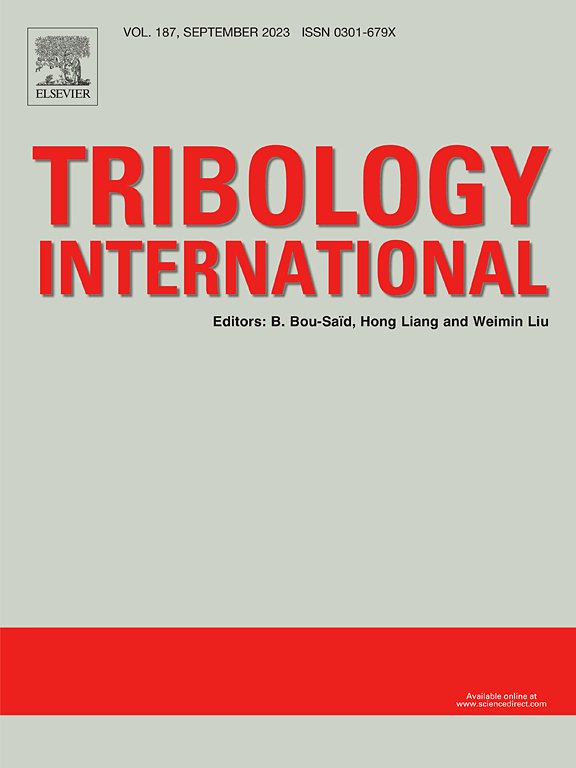Tribological properties and molecular dynamics analysis of citric acid modified 3D porous graphene/carbon black as lubricant additives
IF 6.1
1区 工程技术
Q1 ENGINEERING, MECHANICAL
引用次数: 0
Abstract
Graphene holds significant potential as a green additive for lubricating oils, but its poor dispersion stability limits its applications. In this study, citric acid-modified graphene (CAG) was prepared by modifying 3D porous graphene with citric acid, achieving stable dispersion in lubricating oil for up to six months without the need for dispersants. The lubricating properties were investigated using a four-ball friction tester, and wear scars were characterized using the depth-of-field microscope, Scanning electron microscopy (SEM), and Raman spectroscopy. The experimental results demonstrated that adding a composite (CC) of CAG and carbon black to castor oil reduced the coefficient of friction (COF) and anti-wear by 24.57 % and 70.27 %, respectively, under a load of 392 N. Under a load of 588 N, the COF and anti-wear decreased by 32.59 % and 56.54 %, respectively, while the last non-seizure load (PB) increased by 125.26 %. The sheet-like CAG adsorbed onto the friction surface, enhancing the oil film's load-carrying capacity, while the spherical carbon black acted as microbearings, converting part of the sliding friction into rolling lubrication. A synergistic effect between CAG and carbon black was observed, with the composite exhibiting better lubricating performance than either material alone. Moreover, molecular dynamics simulation results revealed that adding CAG alone enhanced the lubricant's adsorption but reduced its mobility. The combined addition of CAG and carbon black retained the improved adsorption while enhancing the lubricant's mobility, further confirming the synergistic action between CAG and carbon black.
柠檬酸改性三维多孔石墨烯/炭黑润滑添加剂的摩擦学性能及分子动力学分析
石墨烯作为一种绿色润滑油添加剂具有巨大的潜力,但其分散稳定性差限制了其应用。在这项研究中,柠檬酸修饰石墨烯(CAG)是通过用柠檬酸修饰三维多孔石墨烯制备的,在不需要分散剂的情况下,在润滑油中实现了长达6个月的稳定分散。采用四球摩擦试验机对其润滑性能进行了研究,并利用景深显微镜、扫描电镜和拉曼光谱对磨损痕进行了表征。实验结果表明,蓖麻油中加入CAG和炭黑的复合材料(CC),在392 N的载荷下,摩擦系数(COF)和抗磨系数(COF)分别降低了24.57 %和70.27 %。在588 N的载荷下,COF和抗磨性能分别下降了32.59 %和56.54 %,而末次无发作载荷(PB)增加了125.26 %。片状CAG吸附在摩擦表面,增强了油膜的承载能力,而球形炭黑作为微轴承,将部分滑动摩擦转化为滚动润滑。CAG与炭黑之间存在协同效应,复合材料的润滑性能优于单独使用任何一种材料。此外,分子动力学模拟结果表明,单独添加CAG可以增强润滑油的吸附,但会降低其迁移率。CAG与炭黑的联合添加,在保持原有的吸附性能的同时,增强了润滑油的流动性,进一步证实了CAG与炭黑之间的协同作用。
本文章由计算机程序翻译,如有差异,请以英文原文为准。
求助全文
约1分钟内获得全文
求助全文
来源期刊

Tribology International
工程技术-工程:机械
CiteScore
10.10
自引率
16.10%
发文量
627
审稿时长
35 days
期刊介绍:
Tribology is the science of rubbing surfaces and contributes to every facet of our everyday life, from live cell friction to engine lubrication and seismology. As such tribology is truly multidisciplinary and this extraordinary breadth of scientific interest is reflected in the scope of Tribology International.
Tribology International seeks to publish original research papers of the highest scientific quality to provide an archival resource for scientists from all backgrounds. Written contributions are invited reporting experimental and modelling studies both in established areas of tribology and emerging fields. Scientific topics include the physics or chemistry of tribo-surfaces, bio-tribology, surface engineering and materials, contact mechanics, nano-tribology, lubricants and hydrodynamic lubrication.
 求助内容:
求助内容: 应助结果提醒方式:
应助结果提醒方式:


